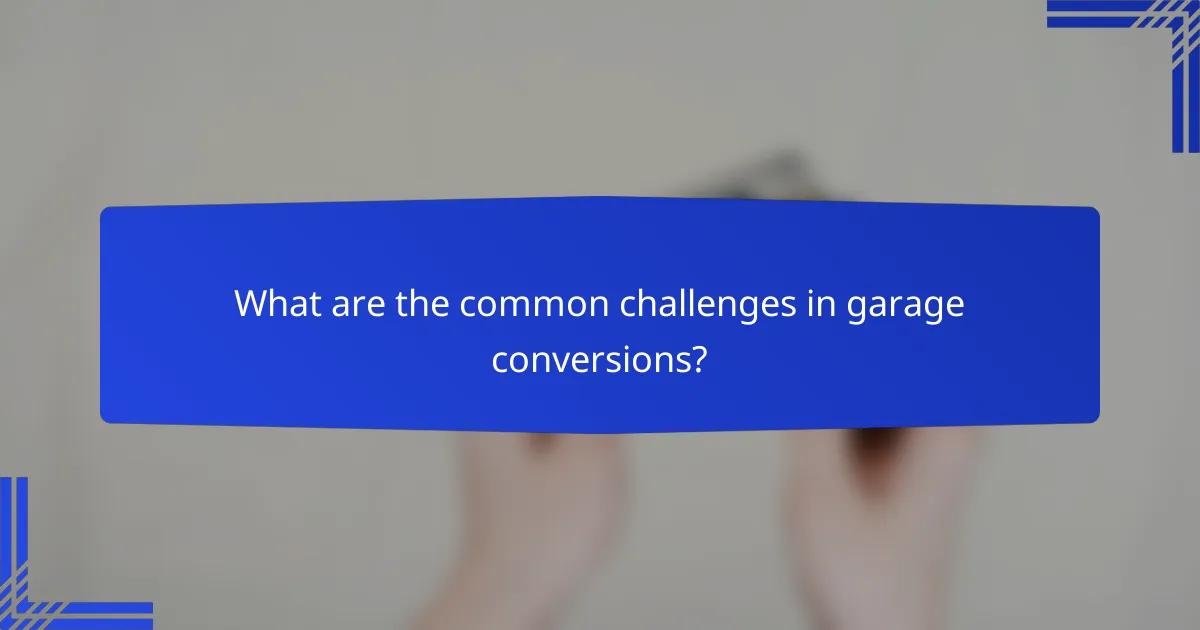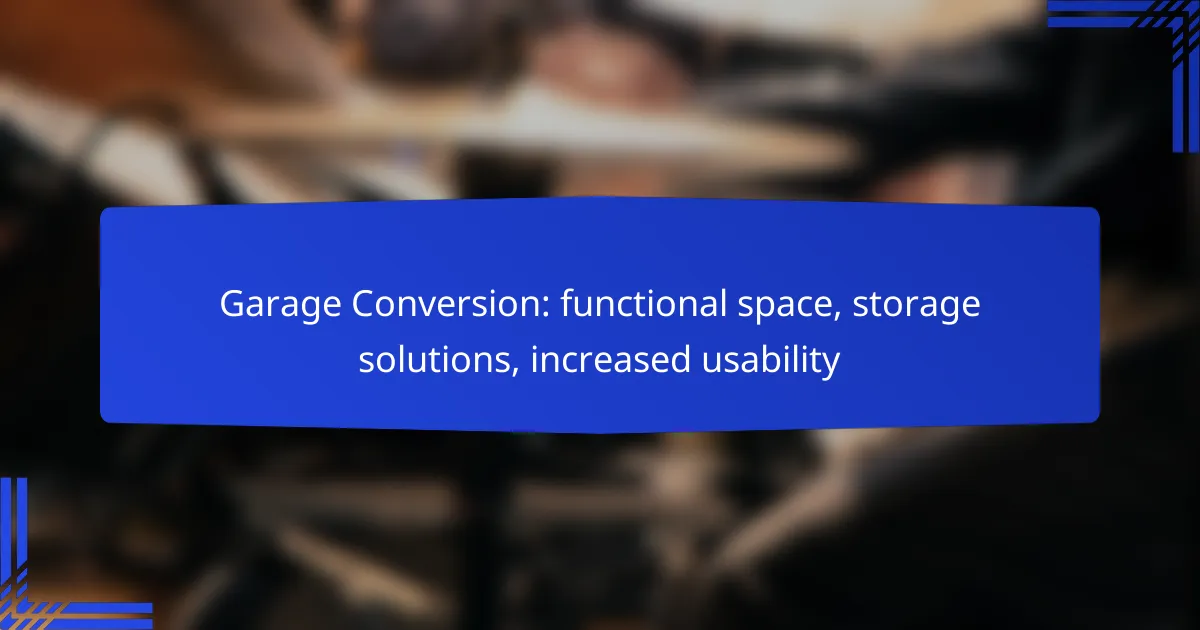Garage conversion presents an excellent opportunity to maximize usable space in your home, transforming an often-overlooked area into a functional living space. Whether you envision a cozy guest room, a productive home office, or an organized storage area, careful planning and design can help you achieve your goals while enhancing your property’s value. By incorporating smart storage solutions, you can ensure that your new space remains both practical and inviting.

What are the benefits of garage conversion in the UK?
Garage conversion in the UK offers numerous advantages, including maximizing usable space, enhancing property value, and providing flexible design options. Homeowners can transform an underutilized garage into a functional area that meets their needs, whether for storage, living space, or a home office.
Increased usable space
Converting a garage significantly increases the usable space in a home, allowing for more functional areas without the need for an extension. This space can be utilized for various purposes, such as a playroom, gym, or guest room, depending on individual requirements.
When planning a garage conversion, consider the layout and how it integrates with the rest of the home. Ensure that the new space is accessible and complements existing areas to maximize its usability.
Enhanced property value
A well-executed garage conversion can boost a property’s market value, often recouping a substantial portion of the conversion costs. In the UK, homeowners can expect to see an increase in value ranging from 10% to 20%, depending on the quality of the conversion and the local property market.
To maximize property value, focus on high-quality finishes and ensure that the new space is functional and appealing to potential buyers. Avoid overly personalized designs that may not appeal to a broad audience.
Flexible design options
Garage conversions offer a wide range of design possibilities, allowing homeowners to tailor the space to their specific needs and preferences. Options include creating an open-plan living area, a separate office, or even a self-contained apartment.
When designing the space, consider factors such as natural light, insulation, and ventilation. Using modular furniture can also enhance flexibility, enabling easy reconfiguration as needs change over time.

How can I convert my garage into a functional living space?
Converting your garage into a functional living space involves transforming it into an area that serves a specific purpose, such as a guest room, office, or recreational area. This process typically requires careful planning, design considerations, and budget estimation to ensure the space meets your needs and complies with local regulations.
Planning permission requirements
Before starting your garage conversion, check if you need planning permission. In many areas, converting a garage into a living space may require approval from local authorities, especially if it alters the structure or external appearance of the building.
Common requirements may include compliance with building codes, zoning laws, and ensuring that the conversion does not affect parking regulations. It’s advisable to consult your local planning office for specific guidelines and to avoid potential fines or the need for costly modifications later.
Design considerations
Designing a functional living space from your garage involves assessing the layout, insulation, and lighting. Consider how you will use the space and what features are essential, such as windows for natural light, adequate heating, and ventilation.
Additionally, think about storage solutions to maximize usability. Built-in shelves, multifunctional furniture, and smart organization can help maintain a tidy and efficient environment. Ensure that the design aligns with your home’s overall aesthetic for a cohesive look.
Cost estimation
The cost of converting a garage can vary significantly based on factors like size, materials, and labor. On average, homeowners might spend anywhere from a few thousand to tens of thousands of dollars, depending on the complexity of the project and the finishes chosen.
To create a realistic budget, consider obtaining quotes from contractors, accounting for permits, materials, and potential unexpected expenses. Prioritize essential features first, and explore cost-effective options to keep the project within your financial means.

What storage solutions can be integrated into a garage conversion?
Integrating effective storage solutions into a garage conversion enhances functionality and maximizes space. Consider options that cater to your specific needs, allowing for organized storage while maintaining usability.
Built-in shelving units
Built-in shelving units are an excellent way to utilize vertical space in a garage conversion. They can be customized to fit the dimensions of your garage, providing ample room for tools, boxes, and other items. Opt for adjustable shelves to accommodate various sizes of storage containers.
When designing built-in shelving, consider materials that are durable and easy to clean, such as plywood or metal. Ensure that the shelves are securely anchored to the wall to support heavier items without risk of collapse.
Multi-functional furniture
Multi-functional furniture serves dual purposes, making it ideal for garage conversions. For example, a bench with storage underneath can provide seating while also housing tools or outdoor gear. Look for items that can easily transition between uses, such as foldable tables or ottomans with hidden compartments.
When selecting multi-functional pieces, prioritize quality and durability, especially if they will be used frequently. This approach not only saves space but also adds versatility to your garage environment.
Vertical storage systems
Vertical storage systems are essential for maximizing floor space in a garage conversion. These systems can include wall-mounted racks, pegboards, or tall cabinets that utilize height rather than width. This is particularly beneficial in smaller garages where floor space is limited.
Consider incorporating hooks and bins into your vertical storage to keep items organized and easily accessible. Regularly assess your storage needs to ensure that your vertical solutions adapt to changing requirements, such as seasonal equipment or hobby supplies.

What are the common challenges in garage conversions?
Garage conversions often face challenges such as compliance with building regulations, insulation and heating issues, and maximizing usable space. Addressing these factors is crucial to ensure a successful transformation into a functional area.
Building regulations compliance
Compliance with local building regulations is a primary concern during garage conversions. These regulations may dictate structural changes, electrical work, plumbing, and safety standards that must be met to avoid legal issues.
Before starting a conversion, check with your local authority for specific requirements. This may include obtaining necessary permits and ensuring that the new space adheres to zoning laws, which can vary significantly by region.
Insulation and heating issues
Insulation and heating are critical for making a garage conversion comfortable and energy-efficient. Many garages are not built with adequate insulation, which can lead to temperature fluctuations and increased energy costs.
Consider adding insulation to walls, ceilings, and floors to improve thermal performance. Installing a heating system, such as electric radiators or underfloor heating, can also enhance usability, especially in colder climates.

How do I choose the right contractor for my garage conversion?
Choosing the right contractor for your garage conversion involves assessing their experience, checking references, and reviewing their past work. A qualified contractor will help ensure your project meets your needs and complies with local regulations.
Evaluating contractor experience
When evaluating contractor experience, consider how long they have been in the garage conversion business and the number of similar projects they have completed. Look for contractors who specialize in conversions, as they will be more familiar with the specific challenges and requirements involved.
Ask potential contractors about their training and certifications, as well as any relevant licenses required in your area. A contractor with a solid track record will provide you with confidence in their ability to deliver quality work.
Checking references and reviews
Checking references and reviews is crucial in selecting a contractor. Request a list of previous clients and contact them to inquire about their experiences. Ask about the contractor’s reliability, communication, and the quality of the finished work.
Additionally, browse online reviews on platforms like Google or Yelp to gain insights into the contractor’s reputation. Look for patterns in feedback, such as consistent praise or complaints, to help you make an informed decision.

What are the costs associated with garage conversions in the UK?
The costs of garage conversions in the UK can vary significantly, typically ranging from £5,000 to £30,000, depending on the complexity and scope of the project. Factors such as design, materials, and local labor rates will influence the final price.
Factors Influencing Costs
Several factors can impact the overall costs of a garage conversion. The size of the garage, the type of conversion (e.g., living space, office, or storage), and the quality of materials used are key considerations. Additionally, if structural changes or planning permissions are required, these can add to the expenses.
For example, a simple conversion into a home office may cost less than a full conversion into a self-contained living unit, which might require plumbing and electrical work. Always assess your specific needs and budget accordingly.
Potential Additional Expenses
Beyond the initial conversion costs, there may be additional expenses to consider. These can include fees for planning permission, building regulations compliance, and potential landscaping or exterior work. It’s wise to budget an extra 10-15% for unforeseen costs that may arise during the project.
Consulting with a professional can help identify all potential expenses upfront, ensuring a more accurate budget and smoother process.
Cost-Saving Tips
To keep costs manageable, consider doing some of the work yourself, such as painting or minor installations. Additionally, sourcing materials from local suppliers or opting for standard designs can help reduce expenses. Always compare quotes from multiple contractors to find the best value for your project.
Be cautious of overly cheap options, as they may compromise quality or lead to higher costs down the line. Prioritize quality and reliability over the lowest price to ensure a successful conversion.
